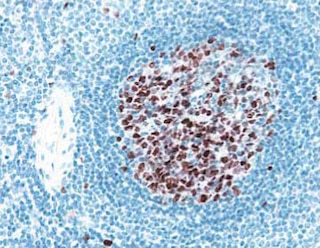-
Your selected country is
Middle East / Africa
- Change country/language
Old Browser
This page has been recently translated and is available in French now.
Looks like you're visiting us from {countryName}.
Would you like to stay on the current country site or be switched to your country?








Western blot analysis of human LDLR expression. Lysate from 293F cells transfected with human LDLR was prepared for electrophoresis (SDS-PAGE) in a 2D Tris-Glycine polyacrylamide gel. The proteins were transferred to PVDF membranes and then probed with 0.25, 0.125, 0.06 & 0.03 µg/mL (lanes 1-4, respectively) of Purified Mouse Anti-Human LDLR. Specific staining was detected with HRP Goat Anti-Mouse Ig (Cat No 554002).

Immunohistochemical staining of LDLR in human hepatic lipidosis (top row) and hepatic cancer (bottom row). Following antigen retrieval with BD Retrievagen A buffer (Cat. No. 550524), the formalin-fixed paraffin-embedded tissue sections were blocked using an Avidin/ Biotin Blocking Kit (Vector Laboratories, Cat. No. SP-2001) as recommended by the manufacturer. They were stained with either Purified Mouse IgG2b Isotype Control (Cat.No. 557351; Left column) or Purified Mouse Anti-Human LDLR antibody (Right column). A three-step staining procedure that employs Biotin Goat Anti-Mouse Immunoglobulin (Cat. No. 550337), Streptavidin-Horseradish Peroxidase (HRP) (Cat. No.550946), and the DAB Substrate Kit (Cat. No. 550880) was used to develop the primary staining reagents. The cell surface and cytoplasm stained positively for the expression of LDLR. Original magnification: 40×.

Flow cytometric analysis of human LDLR expression. Untransfected (dashed-line histogram) and human LDLR transfected (solid-line histogram) 293F cells were washed and stained with Purified Mouse Anti-Human LDLR followed by PE Goat Anti-Mouse Ig (Cat. No. 550589). The fluorescence histograms were derived from gated events with the forward and side light-scatter characteristics of intact cells. Flow cytometry was performed on a BD FACSCanto™ II cell analyzer.


BD Pharmingen™ Purified Mouse Anti-Human LDLR

BD Pharmingen™ Purified Mouse Anti-Human LDLR

BD Pharmingen™ Purified Mouse Anti-Human LDLR

Regulatory Status Legend
Any use of products other than the permitted use without the express written authorization of Becton, Dickinson and Company is strictly prohibited.
Preparation And Storage
Product Notices
- Since applications vary, each investigator should titrate the reagent to obtain optimal results.
- Please refer to www.bdbiosciences.com/us/s/resources for technical protocols.
- Caution: Sodium azide yields highly toxic hydrazoic acid under acidic conditions. Dilute azide compounds in running water before discarding to avoid accumulation of potentially explosive deposits in plumbing.
- Sodium azide is a reversible inhibitor of oxidative metabolism; therefore, antibody preparations containing this preservative agent must not be used in cell cultures nor injected into animals. Sodium azide may be removed by washing stained cells or plate-bound antibody or dialyzing soluble antibody in sodium azide-free buffer. Since endotoxin may also affect the results of functional studies, we recommend the NA/LE (No Azide/Low Endotoxin) antibody format, if available, for in vitro and in vivo use.
- An isotype control should be used at the same concentration as the antibody of interest.
Companion Products



.png?imwidth=320)


The C7 monoclonal antibody specifically binds to the low-density lipoprotein (LDL) receptor, a type I membrane protein that is encoded by the LDLR gene. LDL is the major cholesterol-carrying lipoprotein in plasma. Cell surface LDLR controls the level of cholesterol in plasma by binding to and internalizing LDL and transporting it to lysosomes where LDL is degraded, cholesterol is released into the cell, and LDLR is recycled back to the cell surface. Hence LDLR is found in cell-surface and intracellular membranes (eg, clathrin-coated pits, golgi, endosomes, and lysosomes). Expression of LDLR is a marker for in vitro differentiation of hepatocytes from human embryonic stem cells. LDLR is suspected to mediate infections by viruses that associate with lipoprotein in the blood. Mutations in LDLR are largely responsible for Familial Hypercholesterolemia (FH). The C7 monoclonal antibody has been reported to react with bovine and human LDLR, but not LDLRs of mouse, rat, Chinese hamster, rabbit or dog.
Development References (6)
-
Beisiegel U, Schneider WJ, Brown MS, Goldstein JL. Immunoblot analysis of low density lipoprotein receptors in fibroblasts from subjects with familial hypercholesterolemia. J Biol Chem. 1982; 257:13150-13156. (Clone-specific: Western blot). View Reference
-
Beisiegel U, Schneider WJ, Goldstein JL, Anderson RG, Brown MS. Monoclonal antibodies to the low density lipoprotein receptor as probes for study of receptor-mediated endocytosis and the genetics of familial hypercholesterolemia. J Biol Chem. 1981; 256(22):11923-11931. (Immunogen). View Reference
-
Francke U, Brown MS, Goldstein JL. Assignment of the human gene for the low density lipoprotein receptor to chromosome 19: synteny of a receptor, a ligand, and a genetic disease. Proc Natl Acad Sci U S A. 1984; 81(9):2826-2830. (Clone-specific: Immunoprecipitation). View Reference
-
Schneider WJ, Beisiegel U, Goldstein JL, Brown MS. Purification of the low density lipoprotein receptor, an acidic glycoprotein of 164,000 molecular weight. J Biol Chem. 1982; 257:2664-26673. (Clone-specific: Immunoaffinity chromatography). View Reference
-
Touboul T, Hannan NR, Corbineau S, et al. Generation of functional hepatocytes from human embryonic stem cells under chemically defined conditions that recapitulate liver development. Hepatology. 2010; 51(5):1754-1765. (Biology). View Reference
-
Yamamoto T, Davis CG, Brown MS, et al. The human LDL receptor: a cysteine-rich protein with multiple Alu sequences in its mRNA. Cell. 1984; 39(1):27-38. (Biology). View Reference
Please refer to Support Documents for Quality Certificates
Global - Refer to manufacturer's instructions for use and related User Manuals and Technical data sheets before using this products as described
Comparisons, where applicable, are made against older BD Technology, manual methods or are general performance claims. Comparisons are not made against non-BD technologies, unless otherwise noted.
For Research Use Only. Not for use in diagnostic or therapeutic procedures.
Report a Site Issue
This form is intended to help us improve our website experience. For other support, please visit our Contact Us page.